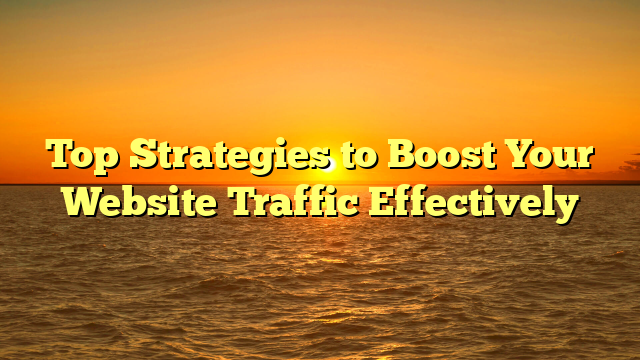In today’s competitive digital landscape, driving traffic to your website is more crucial than ever. With countless businesses vying for attention online, it’s essential to implement effective strategies that not only attract visitors but also engage and convert them. Here are the top strategies to boost your website traffic effectively.
1. Optimize for Search Engines (SEO)
Search Engine Optimization (SEO) is the cornerstone of any successful online presence. By optimizing your website for search engines, you increase your visibility to users searching for keywords related to your business.
- Keyword Research: Use tools like Google Keyword Planner or SEMrush to identify relevant keywords with high search volume and low competition.
- On-Page SEO: Incorporate keywords naturally into your content, meta descriptions, headers, and image alt tags.
- Technical SEO: Ensure your website has a fast loading speed, mobile optimization, and an XML sitemap.
- Quality Backlinks: Build backlinks from reputable websites to improve your domain authority.
2. Leverage Content Marketing
High-quality, valuable content attracts and retains audience attention. Content marketing is not just about blogging; it’s about creating a variety of content that resonates with your target audience.
- Create Engaging Blog Posts: Write informative articles that address your audience’s pain points.
- Utilize Video Content: Produce videos to explain complex ideas or showcase products.
- Infographics: Share data and statistics in a visually appealing format.
- Guest Posting: Write articles for other websites in your industry to tap into their audience.
3. Utilize Social Media Platforms
Social media is a powerful tool for driving traffic and engaging with your audience.
- Choose the Right Platforms: Focus on platforms where your target audience is most active.
- Consistent Posting Schedule: Maintain a regular posting schedule to stay visible.
- Engage with Followers: Respond to comments and messages promptly to build relationships.
- Use Hashtags: Incorporate relevant hashtags to increase your content’s discoverability.
4. Invest in Paid Advertising
While organic traffic is valuable, paid advertising can provide immediate results.
- Google Ads: Use search ads to appear at the top of search engine results pages (SERPs).
- Social Media Ads: Platforms like Facebook and Instagram offer targeted advertising options.
- Retargeting Campaigns: Re-engage visitors who have previously interacted with your website.
- Budget Management: Set clear budgets and monitor ROI to ensure cost-effectiveness.
5. Build an Email Marketing Campaign
Email marketing remains one of the most effective ways to reach your audience directly.
- Collect Emails: Use sign-up forms and incentives like eBooks or discounts.
- Segment Your List: Categorize subscribers based on behavior or demographics for personalized content.
- Craft Compelling Emails: Write engaging subject lines and provide valuable content.
- Analyze Performance: Monitor open rates and click-through rates to optimize future campaigns.
6. Collaborate with Influencers
Influencer marketing can expand your reach to new and engaged audiences.
- Identify Relevant Influencers: Look for influencers in your niche with a significant following.
- Authentic Partnerships: Ensure the collaboration feels natural and aligns with your brand values.
- Sponsor Content: Have influencers create content featuring your products or services.
- Track Results: Use specific links or promo codes to measure the impact of the collaboration.
7. Implement Affiliate Marketing
Affiliate marketing allows others to promote your products or services in exchange for a commission.
- Set Up an Affiliate Program: Use platforms like ShareASale or CJ Affiliate.
- Provide Marketing Materials: Supply affiliates with banners, links, and content to promote your offerings.
- Offer Competitive Commissions: Incentivize affiliates with attractive commission rates.
- Monitor Affiliate Activity: Ensure affiliates adhere to your brand guidelines and policies.
8. Ensure Mobile Optimization
With the increasing use of mobile devices, optimizing your website for mobile users is essential.
- Responsive Design: Ensure your website adapts to various screen sizes.
- Fast Loading Times: Optimize images and use caching to improve speed.
- Easy Navigation: Simplify menus and use clear calls-to-action.
- Test on Multiple Devices: Regularly check your site on different devices and browsers.
9. Analyze and Monitor Performance
Regular analysis helps you understand what strategies are working and where improvements are needed.
- Use Analytics Tools: Implement Google Analytics or similar tools to track traffic sources and user behavior.
- Set Measurable Goals: Define KPIs like session duration, bounce rate, and conversion rate.
- A/B Testing: Experiment with different versions of pages or content to see what performs better.
- Adjust Strategies Accordingly: Use data insights to refine your marketing efforts.
Conclusion
Boosting your website traffic requires a multifaceted approach that combines SEO, content marketing, social media engagement, and data analysis. By consistently applying these strategies and adapting to the changing digital environment, you can significantly increase your website’s visibility, attract more visitors, and achieve your business goals.
Remember, the key is to provide value to your audience. Whether through informative content, engaging social media interactions, or personalized email campaigns, focusing on your users’ needs will naturally drive more traffic to your website.

